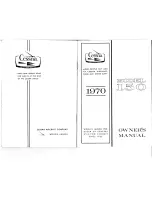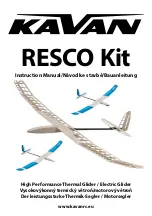
SECTION 8
HANDLING, SERVICE
& MAINTENANCE
CESSNA
MODEL 172RG
GROUND HANDLING
TOWING
The airplane is most easily and safely maneuvered by hand with the
tow-bar attached to the nose wheel. When towing with a vehicle, do not
exceed the nose gear turning angle of 30° either side of center, or damage to
the gear will result. If the airplane is towed or pushed over a rough surface
during hangaring, watch that the normal cushioning action of the nose
strut does not cause excessive vertical movement of the tail and the
resulting contact with low hangar doors or structure. A flat nose tire or
deflated strut will also increase tail height.
PARKING
When parking the airplane, head into the wind and set the parking
brakes. Do not set the parking brakes during cold weather when accumu-
lated moisture may freeze the brakes, or when the brakes are overheated.
Close the cowl flaps, install the control wheel lock and chock the wheels. In
severe weather and high wind conditions, tie the airplane down as outlined
in the following paragraph.
TIE-DOWN
Proper tie-down procedure is the best precaution against damage to
the parked airplane by gusty or strong winds. To tie-down the airplane
securely, proceed as follows:
1. Set the parking brake and install the control wheel lock.
2.
Install a surface control lock over the fin and rudder.
3.
Tie sufficiently strong ropes or chains (700 pounds tensile
strength) to the wing and tail tie-down fittings and secure each
rope to a ramp tie-down.
4. Tie a rope (no chains or cables) to the nose gear torque link and
secure to a ramp tie-down.
5. Install a pitot tube cover.
JACKING
When a requirement exists to jack one or both main gear, the entire
airplane should be jacked by using the wing jack points. Refer to the
Service Manual for specific procedures and equipment required.
If nose gear maintenance is required, the nose wheel may be raised off
the ground by pressing down on a tailcone bulkhead, just forward of the
horizontal stabilizer, and allowing the tail to rest on the tail tie-down ring.
h
8 -8
1 July 1979
CESSNA
SECTION 8
MODEL 172RG
HANDLING, SERVICE
& MAINTENANCE
NOTE
Do not apply pressure on the elevator or outboard stabil-
izer surfaces. When pushing on the tailcone, always apply
pressure at a bulkhead to avoid buckling the skin.
To assist in raising and holding the nose wheel off the ground, weight
down the tail by placing sand-bags, or suitable weights, on each side of the
horizontal stabilizer, next to the fuselage. If ground anchors are available,
the tail should be securely tied down.
NOTE
Ensure that the nose will be held off the ground under all
conditions by means of suitable stands or supports under
weight supporting bulkheads near the nose of the airplane.
LEVELING
Longitudinal leveling of the airplane is accomplished by placing a
level on the leveling screws located on the left side of the tailcone. Deflate
the nose tire and/or lower or raise the nose strut to properly center the
bubble in the level. Corresponding points on both upper door sills may be
used to level the airplane laterally.
FLYABLE STORAGE
Airplanes placed in non-operational storage for a maximum of 30 days
or those which receive only intermittent operational use for the first 25
hours are considered in flyable storage status. Every seventh day during
these periods, the propeller should be rotated by hand through five
revolutions. This action "limbers" the oil and prevents any accumulation
of corrosion on engine cylinder walls.
WARNING
For maximum safety, check that the ignition switch is
OFF, the throttle is closed, the mixture control is in the idle
cut-off position, and the airplane is secured before rotating
the propeller by hand. Do not stand within the arc of the
propeller blades while turning the propeller.
After 30 days, the airplane should be flown for 30 minutes or a ground
runup should be made just long enough to produce an oil temperature
within the lower green arc range. Excessive ground runup should be
avoided.
1 July 1979
8-9















































